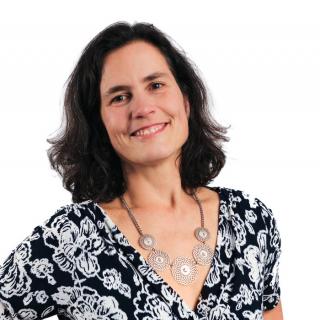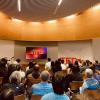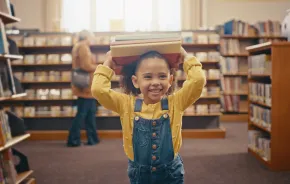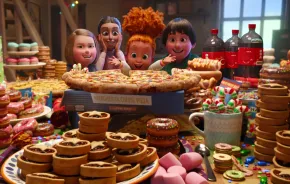
It’s 4 p.m. on a spring Sunday, and the King County Library System’s downtown Bellevue Library shows no signs of taking a rest. Outside, cars circle the parking lot, jockeying for a spot. Inside the building’s three soaring stories, patrons of all ages browse, read, type, chat and even snack — there is a small café area with vending machines.

At the back of the first floor, a large, glassed-in “creativity lab” called the ideaX Makerspace is even more abuzz. Sitting at long worktables, about 25 people — mostly pairs of kids and parents, but also a few lone adults — are on a mission of discovery and creativity as they participate in an upcycling workshop. Under the careful facilitation of engineer and educator Jen Fox, they work together to take apart donated electronic parts and turn them into something new.
Questions and exclamations fly: “I wonder what this is?” “I’ve never seen wires like this!” “I found a capacitor!”
As one of the solo adults in that workshop, I took the better part of two hours (with help from Jen and the kind techie guy seated next to me) to dissemble an old remote-control device and reconfigure its coolest elements — the switches — into a mini art piece intended as a gift for my son. Although I did glean micro bits of information about circuit boards and recycling, my biggest takeaway was gratitude — at the opportunity to be part of a multigenerational community of learning that libraries are so adept at creating.
I’ve been thinking about public libraries a lot lately. About how they show up at just the right time, ready to help you with whatever your family needs: to hunt for a job, learn a skill, make a craft, entertain your kids, connect with other parents, listen to stories in your native language, outsource the homework struggle, connect to services or simply get a list of fresh reads for your graphic-novel-obsessed 9-year-old.
And I’ve also been contemplating how, in an era when our country seems more divided than ever, the basic mission of libraries to be a learning refuge that is free, accessible and welcoming to all seems almost revolutionary. Libraries are an everyday miracle, one that’s easy to take for granted. But let’s not: Over the past 30 years, the public library has reshaped itself in ways that few could have predicted at the dawn of the internet, and in many ways, it has become more vital than ever.
“Libraries have really evolved with the way that society has evolved,” says Julie Acteson, director of community relations and marketing for the King County Library System (KCLS). “In doing so, we’ve become even more relevant than we were 20, 30 or 40 years ago, when maybe you just thought of going to a library to check out a book.”

KCLS’s ideaX Makerspace — outfitted with a 3-D printing machine, laser cutter and sewing machine, as well as arts and crafts supplies — is just one example of library innovation. There are dozens — hundreds? — of others, often developed in partnership with other organizations. (See related story, Amazing and Free Library Services Every Seattle-Area Family Should Know About)
And though the Puget Sound area doesn’t yet have a library with a kids’ climbing wall (Calgary Public Library) or seed exchange (Nashville), our library systems are keeping up just fine — which maybe shouldn’t be surprising for a corner of the country that invented the Nancy Pearl librarian action figure. Although circulation of physical materials is down (a national trend), circulation of electronic materials is soaring — by 250 percent among Seattle Public Library (SPL) materials since 2012. KCLS, which just opened its 50th library in a former casino in Kent, leads the country in digital downloads of library materials.
Even more interesting is that libraries are more focused than ever on listening — and responding — to what their communities need.
High-tech, high-touch
When the Pierce County Library System’s Susan Anderson-Newham was attending library school in the 1990s, one of her professors said he believed that libraries would be put out of the information business by the advent of the internet.
“He thought they’d disappear,” remembers Anderson-Newham, who oversees the Pierce County Library System’s early-learning services.
Instead, in a now well-known story line, public library systems evolved to lead the way in providing access to technology, from digitizing their own services (remember the days before you could reserve books online?) to adding Wi-Fi, computer labs, and access to digital books and media through services such as OverDrive. New kinds of tech education are introduced all the time (my favorite new find is KCLS’s Tech Tutor program).
But even as they’ve embraced technology advances, libraries somehow feel more personal than ever.
Parents I polled about their connection to their branch libraries praised the convenience of online services, but also spoke movingly about the difference that library visits have made in their kids’ lives, often through one-on-one exchanges with librarians or spending time in a children’s section stocked with toys and books.
“I see our library as an extension of the community,” says Seattle resident Leah Gotz, who is the admissions and marketing manager for Seattle Jewish Community School. Gotz’s 3-and-a-half-year-old daughter recently got her first library card. “It seems a lot more tuned in to the kid experience than it used to be.”

The decidedly non-tech but incredibly diverse array of story times, which are offered in many languages in our region’s libraries (KCLS has story times in 15 languages), is often the library gateway for parents with young kids. There are baby story times, family story times, pajama and holiday story times, STEAM story times, firefighter story times, yoga story times and maybe even a drag queen story time in June.
Story times and other early-learning events can help children whose families can’t afford preschool gain exposure to pre-K learning — through not just stories, but movement, song and performance — and serve as an anchor for more library exploration.
They also provide a sense of community that can be critical for new parents.
Shin Yu Pai, a Seattle poet who works as the head of the Obscura Society, wrote me that when she was a new mother, finding a baby story time at SPL’s Ballard branch “saved my life.” Although she didn’t always talk to other parents, the action of getting out of the house and having a welcoming place to go where her son was engaged made a huge difference in her well-being. “It’s that sense of being out in the community and feeling like other people are in the struggle with you,” she says.
At my own newly remodeled Lake City branch of SPL, this sense of community is manifested everywhere. Teen services librarian Nancy Garrett runs the busiest Homework Help program in the city, with anywhere from 10 to 40 children showing up on weeknights for tutoring during the school year.
Beloved Lake City children’s librarian Nancy Pew (or Nancy P., as she’s known) greets young patrons by name, helps them choose books and oversees a range of creative events, from family story times to craft extravaganzas.
She’s also just as likely to be visiting a community event, day-care program or running a library stand at the weekly farmers market — always making connections with families to help make the library their own. “I hope that [community members] have a sense that this is their library,” says Pew. “I want people to express themselves. I’m here to fill in the gaps.”
Originally from Mexico, Lake City community member Peggy Hernandez (disclosure: she’s a friend) has attended branch events with her husband and three children for years. She now works with Pew on creating culturally relevant events at the library, and is co-organizer of a community group called Lake City Collective, which uses library spaces to conduct its meetings.
She speaks eloquently about how important libraries are for immigrant and refugee families: “When you come from a different country, [the library] is your second home.”
Summer learning and co-creation
In 1919, an enterprising children’s librarian in Seattle started the city’s first Vacation Reading Club. More than 400 children participated in the program, which involved reading 10 books from the reading club collections and giving an oral report on each to the children’s librarian — sometimes “with fear and trembling,” according to one account.
One hundred years later, the concept of the Vacation Reading Club has evolved right along with public libraries. In 2019, for example, SPL’s Summer of Learning will feature a theme called “Explore Your World!” Developed in partnership with Woodland Park Zoo, the program will offer a variety of events and hands-on activities all over the city, from fossil-sorting programs to interactive music events to opportunities for older kids to participate in actual citizen science.

And though there will still be a “reading action guide” with challenges, this year, Seattle kids don’t need to do anything to “earn” a free book. Seattle children’s librarians, explains the Northgate branch library’s Claire Scott, are focused on getting free books in the hands of kids who most need them, as early as possible.
“This way we can make sure that as many kids as possible have a book of their choice to read over the summer months — something that has been proven to decrease ‘summer slide’ and create positive academic and literacy outcomes for students,” she wrote in an email.
In Scott’s case, this means that in addition to her work in the library building itself, she’ll be handing out books at parks, Northgate Mall and other places where Northgate-area kids hang out. “When we think about our library patrons, well, the library belongs to everybody in a community, right? Not just to the people who can make it to the library during our open hours.”
This concept of universal access to literacy and related services through public libraries can also mean inviting community members to help create culturally relevant programs and materials. Scott cites an example of a group of Somali families that worked with SPL staff (and other organizations) to write and publish the group’s own alphabet book and bilingual counting book.
The books are now published and “available not just for our families, but also for families all over the United States,” says Scott.
This process of “co-creation,” as she calls it, engendered a sense of ownership among the Somali families that was invaluable. “It’s a really huge part of the conversation about equity.”
Back at the Bellevue Library’s ideaX Makerspace, staff librarian Ian Chapman echoes a theme of co-creation. At regular Makerspace events, such as a Friday creativity lab, robotics sessions or an upcycling workshop like the one I attended, kids and adults are always learning from each other.
“There’s almost an exponential learning curve from getting a different person’s viewpoint,” he says.
And Chapman is always learning, too. “We try to be a space where the community provides information,” he says. “In this world, there’s no way we have all the answers.”
Library cards 101Summer is the perfect time for the classic milestone of getting your kids their first library card, an experience on which libraries are giving a more playful spin these days. At the Seattle Public Library, for example, children can choose from a variety of designs, including colorful new cards celebrating different neighborhood libraries, and they also get a cute bag for toting books. At the King County Library System, kids can also choose from custom designs, including limited-edition Russell or Ciara Wilson cards (only available through June, 2019).  Other gee-whiz facts about local library cards:
|
6 Super Kids’ Books That Star a LibraryKid lit is rich in stories in which public libraries play a central role. Here are a few reads suggested by KCLS’s BookMatch and the Seattle Public Library’s Your Next 5 Books programs. (Find the full lists at BookMatch and Your Next 5 Books.) “Lola at the Library” by Anna McQuinn Are you just starting to make library visits a part of your family routine? Try this sweet and nostalgic picture book about Lola’s weekly library visit with her mother, which covers story time, checking out books and more. “Ron’s Big Mission” by Rose Blue and Corinne Naden Libraries weren’t always at the front lines of equity. This book chronicles the true story of 9-year-old Ron McNair, whose insistence on being able to check out books at his South Carolina library helped drive desegregation of the system. Cool postscript: He grew up to become an astronaut.
Dahl’s sweetly subversive story of the girl who defies her TV-addicted parents and overthrows a tyrannical school headmistress is also a love letter to libraries, where Matilda finds the ultimate escape in reading. “Escape From Mr. Lemoncello’s Library” by Chris Grabenstein In this thrilling tale for middle-grade readers, a billionaire game maker invites a dozen 12-year-olds to a lock-in at a super-cool library. How will they get out? Let’s just say the Dewey Decimal System plays a role. “Library on Wheels” by Sharlee Mullins Glenn Peer into the history of public libraries with this engaging account of a Maryland librarian who came up with the idea of a horse-drawn book wagon to bring reading material to her county’s rural residents. “The Story Collector” by Kristin O’Donnell Tubb The New York Public Library is the setting of a mystery novel about an 11-year-old girl named Vivian, who’s determined to find out if the library is haunted. “The Library Book” by Susan Orlean This one is a bonus pick for grown-ups: New Yorker writer Orlean takes a fascinating deep dive into the history of the Los Angeles Public Library (and of libraries in general) and the mystery of the devastating fire that almost destroyed it in 1986. |












